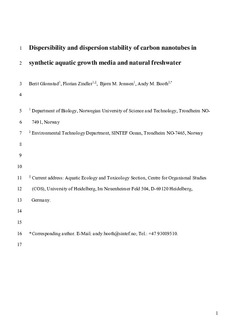| dc.contributor.author | Glomstad, Berit | |
| dc.contributor.author | Zindler, Florian | |
| dc.contributor.author | Jenssen, Bjørn Munro | |
| dc.contributor.author | Booth, Andy | |
| dc.date.accessioned | 2018-09-05T11:17:34Z | |
| dc.date.available | 2018-09-05T11:17:34Z | |
| dc.date.created | 2018-03-04T22:00:42Z | |
| dc.date.issued | 2018 | |
| dc.identifier.citation | Chemosphere. 2018, 201 269-277. | nb_NO |
| dc.identifier.issn | 0045-6535 | |
| dc.identifier.uri | http://hdl.handle.net/11250/2560932 | |
| dc.description.abstract | The dispersion behavior of carbon nanotubes (CNTs) is influenced by both their physicochemical properties and by the aqueous media properties (e.g. ionic strength, presence of divalent cations and natural organic matter) in which they are dispersed. In the current study, the dispersibility and dispersion stability of four multi-walled CNTs (MWCNT) and a single walled CNT (SWCNT) with different physicochemical properties were investigated in three freshwater growth media (with and without natural organic matter; NOM) used in algae and daphnia ecotoxicity studies. CNT dispersion behavior was also investigated in a natural freshwater for comparison. SWCNTs and non-functionalized MWCNTs showed similar dispersibility irrespective of the media type (SWCNTs = 0.5-0.9 mg/L; MWCNTs = 1.5-2.8 mg/L). Functionalized MWCNTs exhibited higher dispersion concentrations, but were more dependent upon the ionic strength and divalent cation concentration of each media (MWCNT-COOH = 3.0-6.6 mg/L). In contrast, CNT surface oxygen content had no influence on CNT dispersibility in the natural water (all MWCNTs = 0.9-1.4 mg/L). Functionalized MWCNTs were affected more by the differences in media properties than non-functionalized MWCNTs. The dispersed CNT concentration decreased over time for all CNT types and in all media due to sedimentation, but was influenced by both CNT and media properties. The study shows how a complex interplay between CNT and media properties can influence the environmental fate of CNTs. Furthermore, the study demonstrates how different CNT types and/or ecotoxicological media in aquatic tests influences the dispersion behavior of the CNTs, and thus their exposure and toxicity to aquatic organisms. | nb_NO |
| dc.language.iso | eng | nb_NO |
| dc.publisher | Elsevier | nb_NO |
| dc.rights | Attribution-NonCommercial-NoDerivatives 4.0 Internasjonal | * |
| dc.rights.uri | http://creativecommons.org/licenses/by-nc-nd/4.0/deed.no | * |
| dc.title | Dispersibility and dispersion stability of carbon nanotubes in synthetic aquatic growth media and natural freshwater | nb_NO |
| dc.type | Journal article | nb_NO |
| dc.type | Peer reviewed | nb_NO |
| dc.description.version | acceptedVersion | nb_NO |
| dc.source.pagenumber | 269-277 | nb_NO |
| dc.source.volume | 201 | nb_NO |
| dc.source.journal | Chemosphere | nb_NO |
| dc.identifier.doi | 10.1016/j.chemosphere.2018.03.019 | |
| dc.identifier.cristin | 1570338 | |
| dc.relation.project | Polish Academy of Sciences: Pol-Nor/237761/98/2014 | nb_NO |
| dc.relation.project | Norges forskningsråd: 209685 | nb_NO |
| dc.description.localcode | © 2018. This is the authors’ accepted and refereed manuscript to the article. Locked until 5.3.2020 due to copyright restrictions. This manuscript version is made available under the CC-BY-NC-ND 4.0 license http://creativecommons.org/licenses/by-nc-nd/4.0/ | nb_NO |
| cristin.unitcode | 194,66,10,0 | |
| cristin.unitname | Institutt for biologi | |
| cristin.ispublished | true | |
| cristin.fulltext | postprint | |
| cristin.qualitycode | 1 | |

